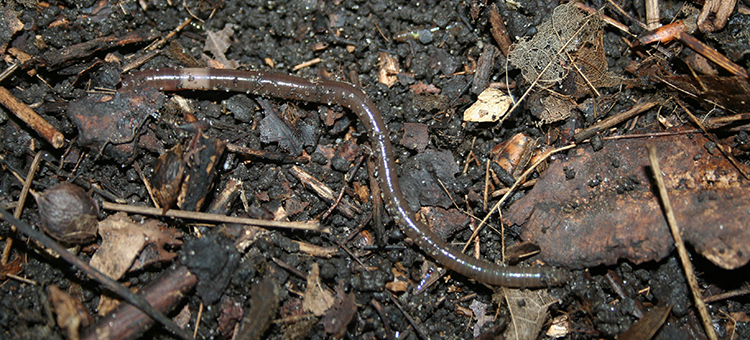
Invasive Asian Jumping worms (JWs) are a new threat to our gardens and Canadian ecosystems. They were confirmed in multiple locations in Ontario in the summer of 2021. They are a serious threat to our gardens and forests. Currently, there are no scientifically recommended management options for them, so prevention is the only choice.
You might have read or heard that it’s not certain yet whether these worms are a serious problem. For instance, this recent segment from CBC suggested we hadn’t seen enough impact to know for sure.
We’ve seen enough evidence to convince us. So many nasty invaders have been allowed to thrive and grow to be serious (and costly) threats while people hummed and hawed about whether the problem was serious. Frankly, we think this is one we should react to NOW.
We need to stop the spread.
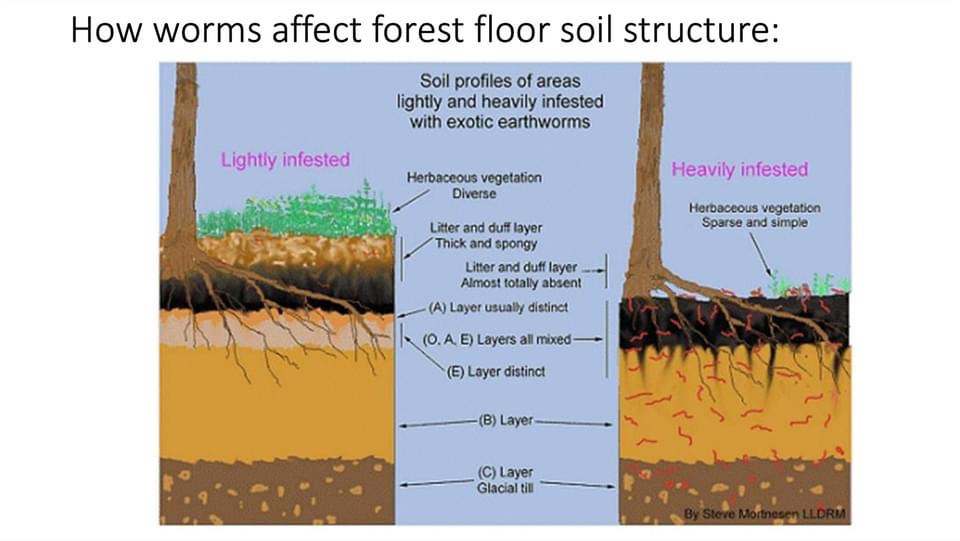
University of Vermont – Effects on exotic worms in forests
These new alien invaders – Jumping Worms – are scary
The University of Minnesota reports “Most growers first notice these very active and abundant adult jumping worms in August or September. These worms vigorously wiggle in a snake-like movement and can lose their tails when aggravated. Some gardeners notice coffee-ground-textured soil that is the casting (worm poop). The texture of the casting is very noticeable and increases soil erosion. Gardeners also report their plants, commonly shallow-rooted plants like hostas, are either doing poorly or actually die.”
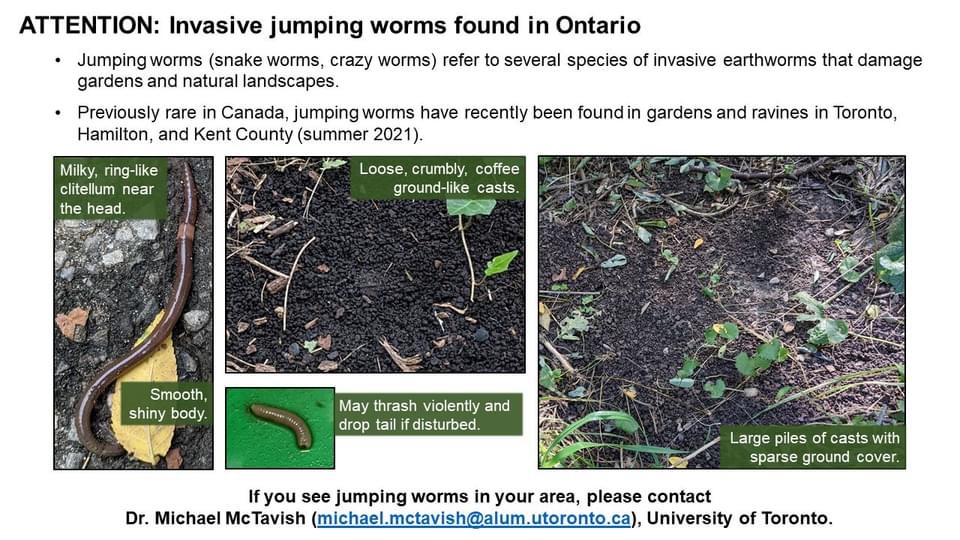
Infographic by Cathy Kavassalis, Master Gardener Ontario
These earthworms are unlike the earthworms we are used to. Jumping worms (JWs), also called crazy worms, are not one species, but a group of pheretimoid worms from Asia that feed in the surface layers of soils. These are annual worms that hatch from eggs in the spring and eat, then start to reproduce (about 60 days later).
They don’t need a partner to reproduce. So just one is potential trouble. In the fall, eggs overwinter in cocoons that look a lot like small balls of dirt. They are easy to accidentally transport in pots of soil, compost, on boots and shoes, or on tires of vehicles. The cocoons are very tolerant of cold so these can spread northward. Cottagers and anglers take extra care!
Because these are annual species, you won’t see any jumping worms at the start of the season. By midsummer, you will notice unusual soil texture if they are present. Their castings (poop) are rich in nutrients. But this fertilizer becomes present at a time when most plants are not actively growing. Rains can wash these nutrients away into our water systems. The processed soil doesn’t hold moisture well and is subject to erosion.
When you disturb these worms in the garden, their behaviour can be scary. Be prepared for a more snake-like creature that flails about and can drop its tail if really agitated. They come in various sizes depending on the species and the growth stage. Look for their distinct ring close to their head-end (the fatter end). It is white or light grey in colour and goes completely around the worm. This is the clitellum, where the worm’s reproductive organs are. In other worms, the clitellum doesn’t go completely around the worm.
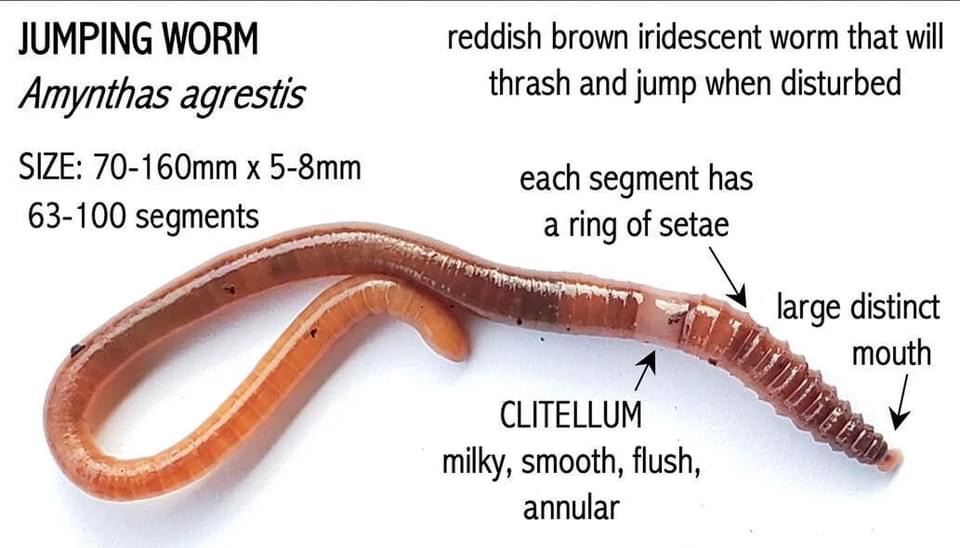
What you Can Do to Help Stop the Spread!
Don’t spread them.
- Clean your shoes before hiking
- Remove soil or debris from your tires if traveling to parks and natural spaces
- Don’t share anything with soil from your garden if you have them
- Be very careful with spring plant sales.
- If sharing plants, wash roots and repot in a quality soil-less mix.
- If purchasing from a grower, ask about their protocols.
- Better yet, grow from seed.
- If visiting private gardens, botanical gardens, or trails, arrive clean (shoes, tires) and leave clean!
When you find them, destroy them.
- Later this summer, if you find JWs, collect and dispose of them. Note – All worms, including the European worms, are invasive, so this means you don’t need to worry if you misidentify the species.
Not sure if you have them? Find out with this simple trick
How to test for Jumping Worms:
○ Mix 1/3 cup ground mustard seed or 1/3 cup mustard powder in 4 Litres (one gallon) of water. You can buy mustard powder in bulk.
○ Remove any leaves or mulch from the soil surface.
○ Slowly pour half the mustard solution over a square foot of soil (30cm x 30 cm) and wait a couple of minutes, then pour the rest. If present, the worms will come to the surface. The mustard won’t kill them, but it is an irritant and will drive them to the surface.
All earthworms will react but look for the white clitellum of the JWs and remove them as they appear. Don’t worry too much about destroying any earthworms you might find. They are also considered invasive.
How to Destroy Jumping Worms & Cocoons
Handpick and destroy JWs using one of these options:
- Place the JWs in a plastic bag in the sun for at least 10 minutes.
- Soak JWs in isopropyl (rubbing) alcohol.
- Put JWs in a bucket of alfalfa pellets. They will dry up very quickly and have no odor.
- Put them in a garbage bag or a container with vinegar or rubbing alcohol.
- Dispose of dead JWs in the garbage. Do not put them in the compost pile or garden.
Treat the Soil / Containers too:
- Solarize the soil in the area where you found JWs. Cocoons are sensitive to heat and can be destroyed with clear plastic solarization. In late spring or summer, cover moistened soil with a sheet of transparent polyethylene for two to three weeks or until the soil temperature exceeds 40°C for at least three days. This method works best in full sun.
- For Containers: Use boiling water to rinse the container thoroughly to kill any cocoons.
If you’ve got these worms report them to Dr. Michael Mctavish michael.mctavish@alum.utoronto
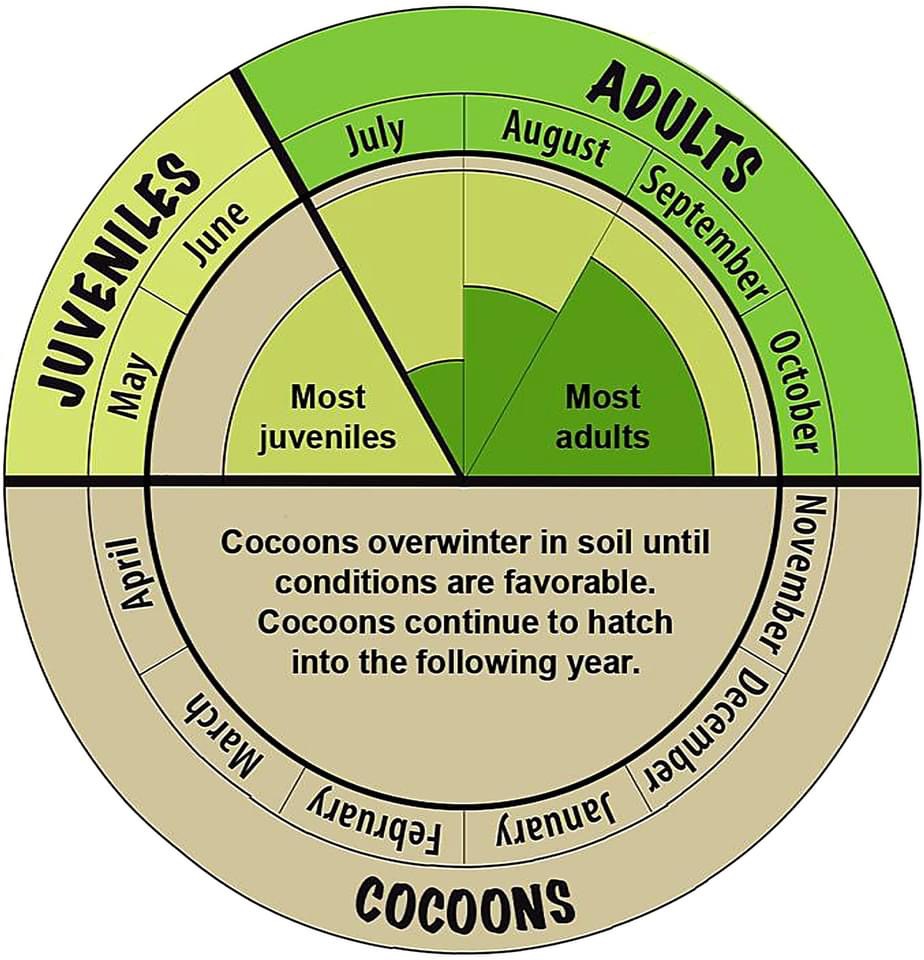
courtesy of Cathy Kavassalis, Master Gardener, Ontario
Introducing New Plants to Your Garden
● Isolate & inspect all new plants before adding them to your garden.
● Inspect the soil. Is it intact or granular? Intact soil is likely OK, granular soil may indicate the presence of JWs.
Purchasing Soil, Mulch & Compost
When purchasing bulk mulch or compost, use a reputable producer that has heat-treated the material to a temperature of at least 40°C (104°F)for at least three days to destroy the cocoons. Compost that was properly heated should not have worms or cocoons, although there is a small chance it can be contaminated via backhoes, handling, etc. It is possible for bagged mulch or soil to also be contaminated.
Consider producing your own compost or leaf mulch.
Plant Sale Tips
Advice for those involved in buying, selling, or exchanging plants. Be cautious!
- Make sure ALL plant sale members are aware of Jumping Worms including what they look like and what contaminated soil looks like.
- DO NOT ACCEPT plants from gardeners with confirmed cases of JWs.
- Sell bare-root plants whenever possible. Completely submerge plant roots in water and wash away the remaining soil. Actively check for JWs.
- If plants must be sold in soil, repot with clean potting soil.
- Do not use mulch, leaves, backyard compost, or other material to repot as they may harbor jumping worm eggs.
- Gather and transport plants/pots where they cannot pick up contaminated materials like soil, leaves, or mulch, e.g. on concrete, tarps, or trays.
- Arrive clean and leave clean. Ensure volunteers clean shoes/boots/tools before arrival and brush off any soil before returning home.
- Vehicles: Be aware that vehicle tires may also transfer JW cocoons to and from the plant sale site. Where possible park vehicles on paved areas such as the street or parking lot.
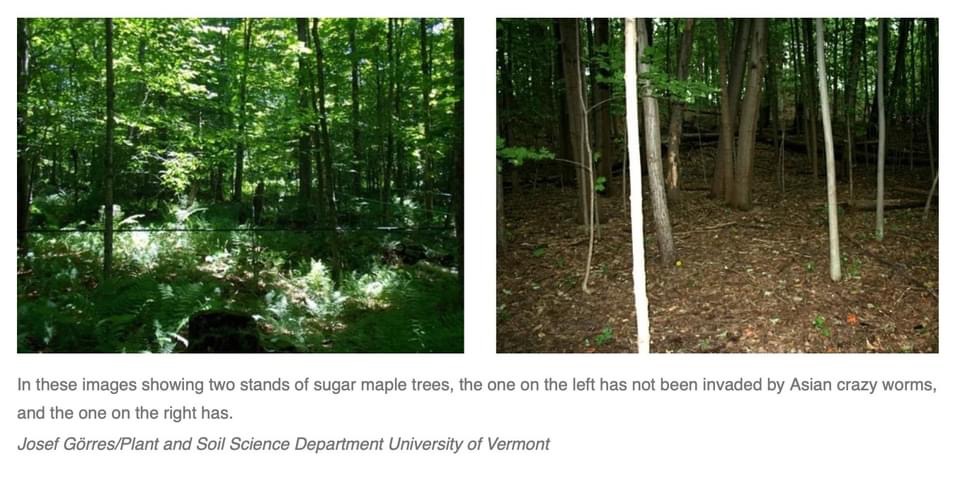
Controls for Jumping Worms
We currently have no viable Jumping Worm control methods, however, the following are being explored:
● Abrasive materials such as biochar (ground-up charcoal) and diatomaceous earth (fossilized diatoms) show some promise in killing adult jumping worms. Incorporate one of these products into the infested soil to a depth where the worms are located.
● Saponins: Saponins are plant-derived chemicals that can act as pesticides. Some golf courses use fertilizers containing saponins to control earthworms in their turf grasses, e.g. Castaway 3-0-1 from Planet Turf, contains saponin oil derived from Camellia sinensis. Saponin-based fertilizers work best when applied after rain or irrigation to expel the earthworms from the soil causing them to desiccate and die. There is a concern about the potential negative impacts of saponins on other soil biotas such as springtails. Alfalfa is another source of saponins.
● While the current advice is for “property owners to contact a pest control company”, consider the following: Because there are no known control options, companies may not be able to do much beyond “limiting” populations. The worms reproduce prolifically and a single egg is all that is needed for them to spread.
Our best option is to try to stop the spread. Let’s all do our part.
Thanks for the major contributions by Master Gardeners Claudette Sims and Cathy Kavassalis!
Learn more from Brad Herrick Seminar on YouTube
Resources
- EDDMaps – Map of Jumping Worm Sightings
- Minnesota Dept of Natural Resources – good article about Jumping Worms
- Jumping Worms – University of Minnesota Extension
- Plant Sales and Jumping Worms – University of New Hampshire
- Cornell University – Invasive Asian Jumping Earthworms
- NC State Extension Jumping Worms
- University of Illinois – Stop the spread of jumping worms and other invasive species
- General Earthworm Diagram – anatomy of an earthworm (Worm Watch)
Feature Photo by Josef Gorres, University of Vermont


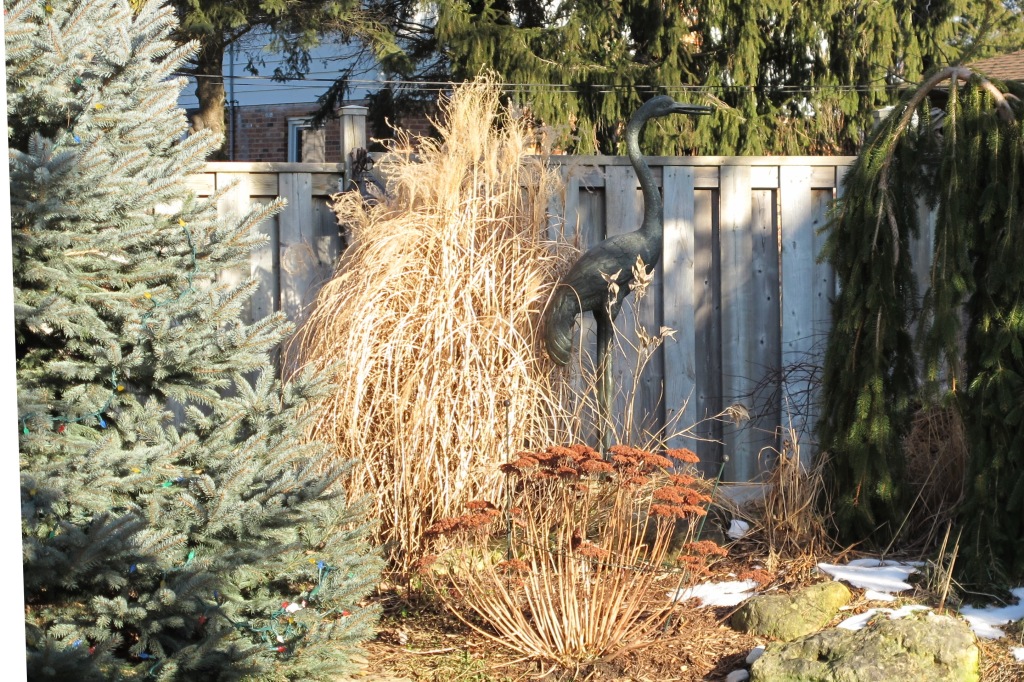


About The Author: Armstrong
As an author and editor, Linda directs her lifelong love of nature and plants to concerns about our environment and how we can do better. In addition to decades of gardening experience, and training as a master gardener, Linda focuses on learning from leading science-based educators and writers, and in the process finds that she uncovers many gardening myths.
More posts by Armstrong